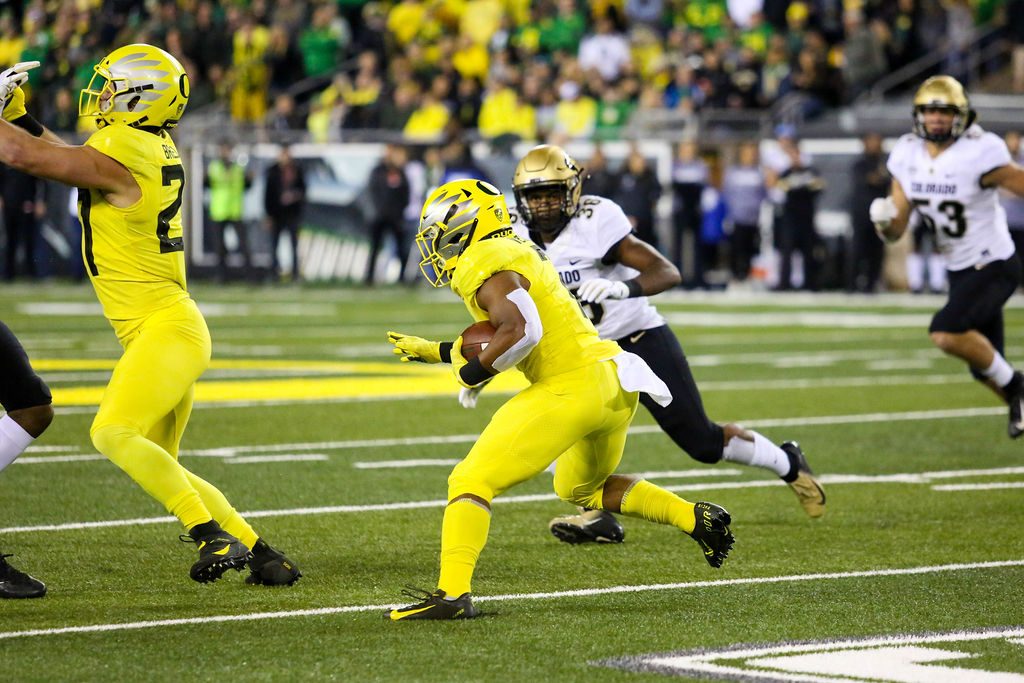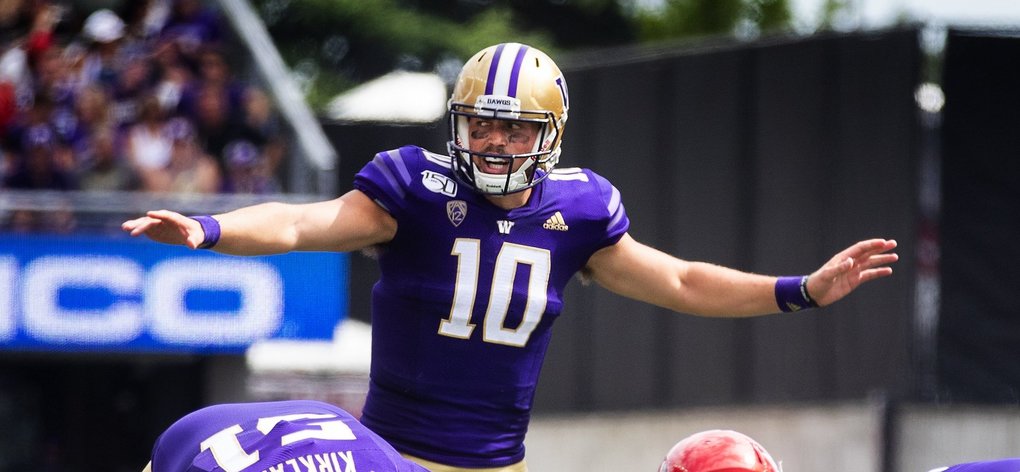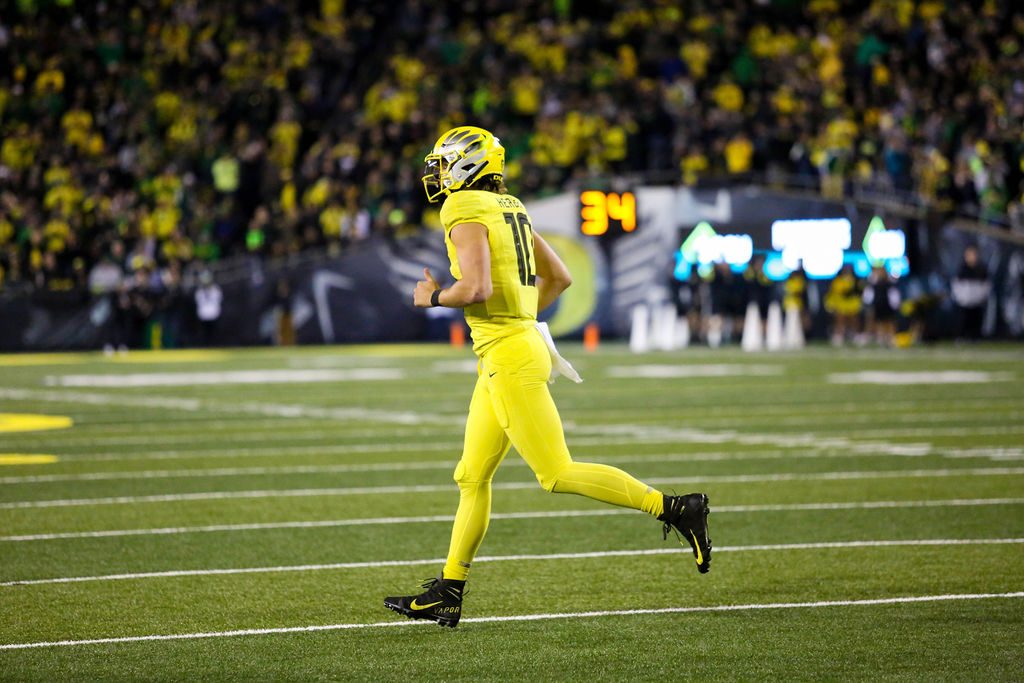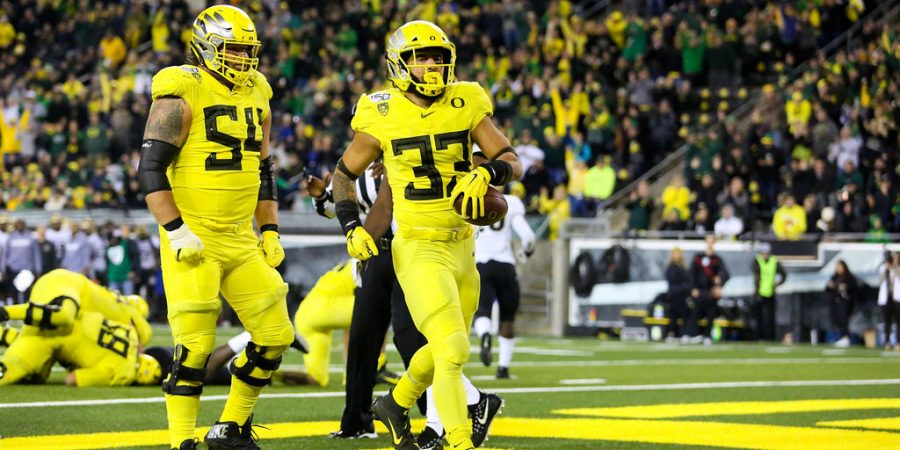The I-5 rivalry between Oregon and Washington gets renewed for the 112th time this Saturday in Seattle, and with it brings an outcome that could produce a Lake Washington-sized ripple effect that alters the landscape in the Pac-12 North division.
This weekend’s matchup between the two divisional favorites is a game in which both teams are relative mirror images of one another. Both are led by stout defenses, both have quarterbacks the NFL draft intelligentsia is fawning over, and both have offensive lines that serve as the backbone for these offenses on the whole.
The relatively even matchup on paper should be fascinating to watch play out on the field, as WFOD takes a closer look at Oregon’s keys to victory over Washington.

1. Win the battle at the line of scrimmage
Somewhat similar to what we saw vs. Auburn in the season opener, this game, in many respects, will be determine by how well each side performs in the offensive and defensive trenches. Against the Tigers, the Ducks more than held their own, though they did show signs of buckling down the stretch as Auburn scratched and clawed their way to a comeback victory after trailing 21-6 in the third quarter. Though Oregon doesn’t figure to face the same kind of challenge on offense as they did against Auburn when facing this Husky defense, the goal remains the same considering Washington’s overall defensive prowess – the Ducks must own the line scrimmage.
On defense, the Huskies have proven to be susceptible in their efforts to stop the run. Through seven games, Washington has surrendered just over four yards per carry (4.21) and 146.7 yards rushing per game, ranking them in the middle of the pack within the conference. Big plays on the ground have also been a bugaboo for the Husky defense, as Washington ranks ninth in rushing plays allowed of 10 yards or more (34) and 11th in rushing plays allowed of 20 yards or more (9). If Oregon’s offensive line can open up holes for CJ Verdell to take advantage of, it could lead to a big day for the sophomore running back who has been running well as of late.
On offense, Washington boasts one of the most experienced offensive lines in the conference next to Oregon. That has translated to effectiveness on the ground between running backs Salvon Ahmed, Richard Newton, and Sean McGrew, who have combined to give the Huskies the third-best rushing offense in the Pac-12 (178.7 yards/game). Oddly enough, however, they have not performed well on third downs, converting just 37.2 percent of their third down opportunities (11th in the Pac-12). Conversely, Oregon has been one of the one of the conference’s best teams at limiting third down conversions, ranking second in the Pac-12 (35.3%). Given the similar strengths of both teams, yards figure to come at a premium on Saturday, but it’s safe to say that who ever wins the battle up front, likely holds the advantage at the end of the game.

2. Make Jacob Eason feel pressure, force him to engineer lengthy drives
For as good as Washington quarterback Jacob Eason has looked at times this season, he’s also had his fair share of moments that have reminded you that his fall camp battle with since-transferred Jake Haener was just that – a battle. Currently ranked second in the conference in passing yards (1,692), fourth in passing touchdowns (13), and fifth in completion percentage (66.0), Eason has feasted on inferior opponents this season.
However, against Power 5 opponents, Eason’s numbers have regressed in stunning fashion. In four games vs. Cal, Stanford, USC, and Arizona this season, Eason has completed just 57 percent of his passes for 791 yards, three touchdowns, and two interceptions. Combine that with the numbers he posted over the course of two seasons at Georgia, and Eason has completed just 55.2 percent of his passes for 2,880 yards (151.6 yards/game), 16 touchdowns, and eight interceptions against Power 5 opponents. In short, when the competition has been at its best, Eason has looked decidedly pedestrian, which is exactly what you like to see if you’re Ducks defensive coordinator Andy Avalos. If the Ducks can dial up pressure and speed up the decision-making process for Eason, it could lead to mistakes, which Oregon has excelled at with 14 forced turnovers to lead the Pac-12. Oregon has also been excellent at limiting big plays from scrimmage, having not allowed a play of 40 yards or more this season. If they can continue their efforts there, that could neutralize the big play element from Eason’s game, forcing him to be patient and consistently accurate delivering the football to his receivers and moving the chains methodically. That could be a tall task against a defense as good as Oregon’s.

3. Protect Justin Herbert and play mistake-free football on offense
With the exception of the game at Stanford and the game vs. Cal, the Ducks have performed rather well this season in both departments. On the road against the Cardinal, Oregon allowed Justin Herbert to be sacked four times in what was their most porous performance thus far this season. It’s worth mentioning that Ducks starting center Jake Hanson was sidelined that day with an injury from the previous week, but it was a revealing look at what could happen against a defense with an effective pass rush. Against Cal, three of Oregon’s five turnovers on the season occurred in that game, proving that the Ducks can be had against a talented and opportunistic defense.
With Washington on deck this week, the Ducks will have to ensure they are air tight in both areas if they hope to make it out of Seattle with a victory. Through seven games, the Huskies rank second in the Pac-12 in sacks (16.0) and are tied for fourth in tackles for loss (36.0). They’ve also shown to be one of the conference’s best teams in terms of takeaways, ranking second behind Oregon with 13. Saturday’s game will have many challenges, but in order to overcome them on the road in hostile territory, they need to keep Herbert upright and minimize the number of opportunities Washington has to put points on the board.

